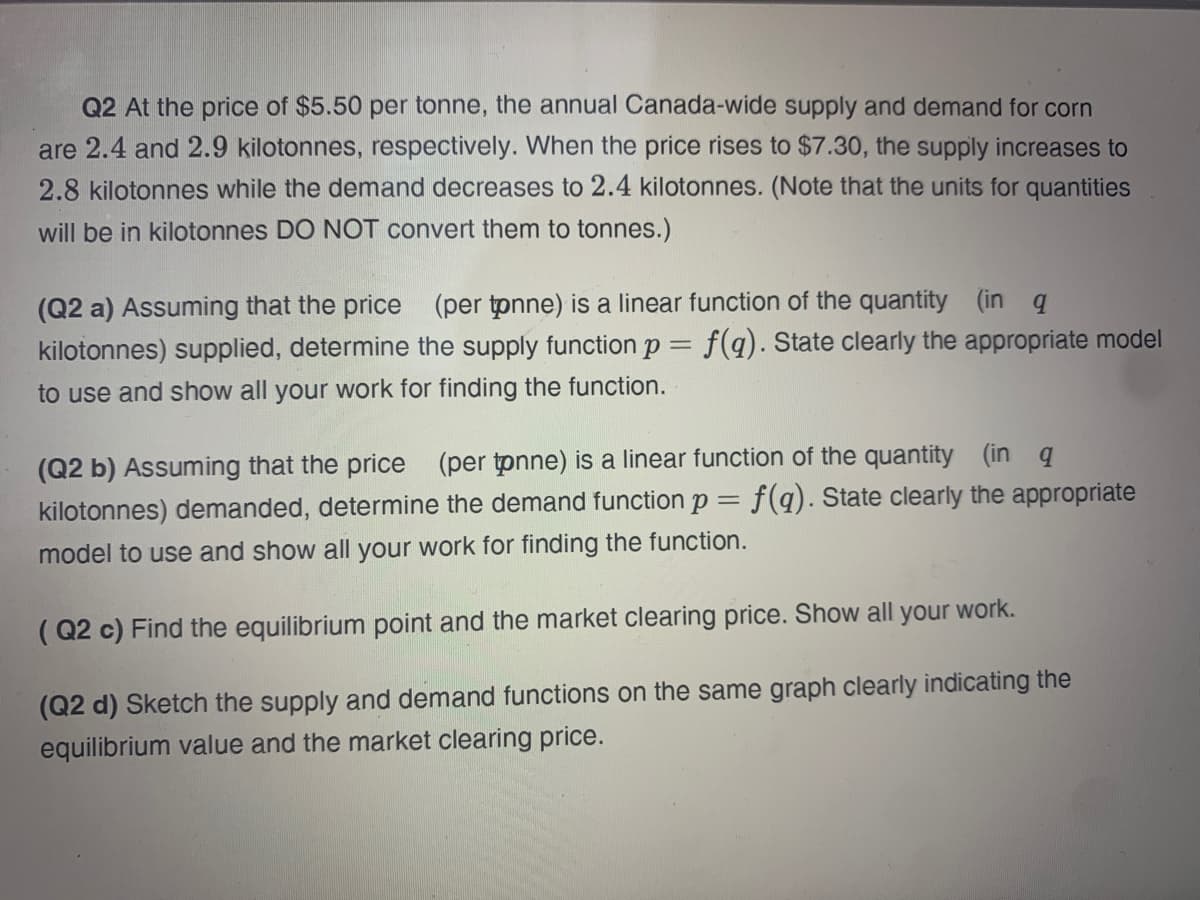Q2 At the price of $5.50 per tonne, the annual Canada-wide supply and demand for corn are 2.4 and 2.9 kilotonnes, respectively. When the price rises to $7.30, the supply increases to 2.8 kilotonnes while the demand decreases to 2.4 kilotonnes. (Note that the units for quantities will be in kilotonnes DO NOT convert them to tonnes.) (Q2 a) Assuming that the price (per tpnne) is a linear function of the quantity (in q kilotonnes) supplied, determine the supply function p f(a). State clearly the appropriate model to use and show all your work for finding the function. (Q2 b) Assuming that the price (per tpnne) is a linear function of the quantity (in q f(q). State clearly the appropriate kilotonnes) demanded, determine the demand function p = model to use and show all your work for finding the function. ( Q2 c) Find the equilibrium point and the market clearing price. Show all your work. (Q2 d) Sketch the supply and demand functions on the same graph clearly indicating the equilibrium value and the market clearing price.
Q2 At the price of $5.50 per tonne, the annual Canada-wide supply and demand for corn are 2.4 and 2.9 kilotonnes, respectively. When the price rises to $7.30, the supply increases to 2.8 kilotonnes while the demand decreases to 2.4 kilotonnes. (Note that the units for quantities will be in kilotonnes DO NOT convert them to tonnes.) (Q2 a) Assuming that the price (per tpnne) is a linear function of the quantity (in q kilotonnes) supplied, determine the supply function p f(a). State clearly the appropriate model to use and show all your work for finding the function. (Q2 b) Assuming that the price (per tpnne) is a linear function of the quantity (in q f(q). State clearly the appropriate kilotonnes) demanded, determine the demand function p = model to use and show all your work for finding the function. ( Q2 c) Find the equilibrium point and the market clearing price. Show all your work. (Q2 d) Sketch the supply and demand functions on the same graph clearly indicating the equilibrium value and the market clearing price.
Managerial Economics: Applications, Strategies and Tactics (MindTap Course List)
14th Edition
ISBN:9781305506381
Author:James R. McGuigan, R. Charles Moyer, Frederick H.deB. Harris
Publisher:James R. McGuigan, R. Charles Moyer, Frederick H.deB. Harris
Chapter5: Business And Economic Forecasting
Section: Chapter Questions
Problem 8E: Bell Greenhouses has estimated its monthly demand for potting soil to be the following: N=400+4X...
Related questions
Question

Transcribed Image Text:Q2 At the price of $5.50 per tonne, the annual Canada-wide supply and demand for corn
are 2.4 and 2.9 kilotonnes, respectively. When the price rises to $7.30, the supply increases to
2.8 kilotonnes while the demand decreases to 2.4 kilotonnes. (Note that the units for quantities
will be in kilotonnes DO NOT convert them to tonnes.)
(Q2 a) Assuming that the price (per tpnne) is a linear function of the quantity (in q
kilotonnes) supplied, determine the supply function p = f(q). State clearly the appropriate model
to use and show all your work for finding the function.
(Q2 b) Assuming that the price (per tpnne) is a linear function of the quantity (in q
kilotonnes) demanded, determine the demand function p = f(q). State clearly the appropriate
model to use and show all your work for finding the function.
( Q2 c) Find the equilibrium point and the market clearing price. Show all your work.
(Q2 d) Sketch the supply and demand functions on the same graph clearly indicating the
equilibrium value and the market clearing price.
Expert Solution
This question has been solved!
Explore an expertly crafted, step-by-step solution for a thorough understanding of key concepts.
Step by step
Solved in 3 steps with 1 images

Knowledge Booster
Learn more about
Need a deep-dive on the concept behind this application? Look no further. Learn more about this topic, economics and related others by exploring similar questions and additional content below.Recommended textbooks for you

Managerial Economics: Applications, Strategies an…
Economics
ISBN:
9781305506381
Author:
James R. McGuigan, R. Charles Moyer, Frederick H.deB. Harris
Publisher:
Cengage Learning

Managerial Economics: Applications, Strategies an…
Economics
ISBN:
9781305506381
Author:
James R. McGuigan, R. Charles Moyer, Frederick H.deB. Harris
Publisher:
Cengage Learning